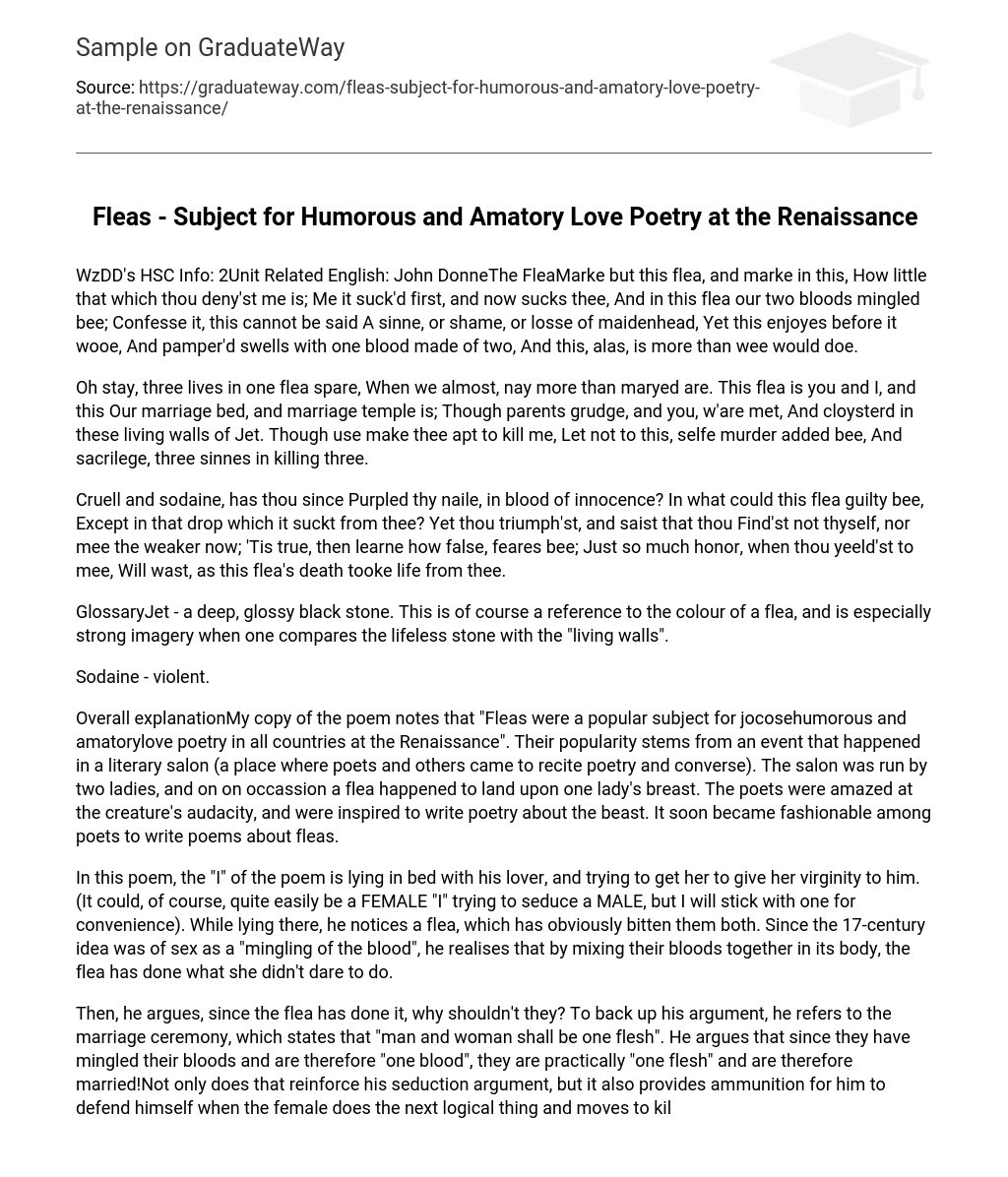My copy of the poem notes that “Fleas were a popular subject for jocosehumorous and amatorylove poetry in all countries at the Renaissance”. Their popularity stems from an event that happened in a literary salon (a place where poets and others came to recite poetry and converse). The salon was run by two ladies, and on on occassion a flea happened to land upon one lady’s breast. The poets were amazed at the creature’s audacity, and were inspired to write poetry about the beast. It soon became fashionable among poets to write poems about fleas.
In this poem, the “I” of the poem is lying in bed with his lover, and trying to get her to give her virginity to him. (It could, of course, quite easily be a FEMALE “I” trying to seduce a MALE, but I will stick with one for convenience). While lying there, he notices a flea, which has obviously bitten them both. Since the 17-century idea was of sex as a “mingling of the blood”, he realises that by mixing their bloods together in its body, the flea has done what she didn’t dare to do.
Then, he argues, since the flea has done it, why shouldn’t they? To back up his argument, he refers to the marriage ceremony, which states that “man and woman shall be one flesh”. He argues that since they have mingled their bloods and are therefore “one blood”, they are practically “one flesh” and are therefore married!Not only does that reinforce his seduction argument, but it also provides ammunition for him to defend himself when the female does the next logical thing and moves to kill the flea.
Donne argues that by spilling his blood and hers by killing the flea, she is practically committing murder. Not only that, but by breaking the holy bond of marriage she is committing sacrilege!However, the flea finally is killed, and the poet is forced to change tactics. There, he argues, killing the flea was easy, and as you say it hasn’t harmed us – well, yielding to me will be just as easy and painless.
This poem borrows a lot of religious imagery, because it helps add an aburd authority to the poem, as Donne tries to argue that what they are about to do is not only supported by God, but to not do it would be heretical. Poetic DevicesDirect address: Marke but this flea… Repetition: And marke in this Conceits: Flea ; Church ; Flea Movement Within the PoemFirst stanza: Contemplative and whimsical Second stanza: Becomes more absurd, pace gets faster Third stanza: Slowing and reversal of argument. Not a good idea to write down, but interesting to note that the pace of the poem follows that of sex – a gradual build-up of intensity leading to the sudden, climactic… death of a flea. Imagery.
Much religious imagery: Confesse itone blood made of two – implies sex and/or pregnancy (ie, mother and child are the “two”)three lives in one flea – holy trinitycloysterdsacrilege, three sinnes in killing three – more holy trinity imageryblood of innocence GenerallyCircular argument. The flea starts and ends as nothing. Hijacking of marriage ceremony. The Anglican marriage ceremony includes the lines Man shall be joined unto his wife and they two shall be one flesh.
Compare with one blood made of two, This flea is you and I…,etc. Argument gains confidence throughout the stanzas, and is then abruptly turned around. Note the role of the female in this poem – her objections are never noted, just reacted to, and she makes the most powerful statement in the poem, yet it is a non-verbal statement (her crushing of the flea) There is a lot of hyperbole in this poem, a technique that Donne often uses to make a point. One blood made of two… – in Donne’s time, the sex act was though to be a “mingling of the bloods” – so the line is both lewd and playful, especially as it is followed by the teasing And this, alas, is more than wee would doe. Purpled thy naile… – purple was a very expensive colour, associated with royalty and romance.
Also note that in the first two lines of this stanza Donne is arguing that the death of the flea is more important than the loss of virginity. Not a good idea to use this in a formal exam, but note Me it suck’d first, and now sucks thee – apparently in the 17th century the printed “s” looked a lot like the printed “f”: “It would be no surprise… that Donne is being deliberately ambivalent here.” (2/3U Related English handout) QuotesThree lives in one flea spare purpled thy naile, in blood of innocence… Just so much honour, when thou yeeld’st to meWill wast, as this flea’s death took life from thee.





